When it comes to getting off the beaten (tourist) path and exploring, Almagro is always my favorite recommendation.
It’s largely unchanged in the likes of Palermo Viejo (er, Soho) and now Chacarita. It retains its original Buenos Aires grit.
But it’s safe, locals live here and it feels like it. The regular routine of going to the mom & pop shops, schools, church and every day routine is obvious. And that makes, in my opinion, for the best people watching and wandering.
Plus there is a lot of history here in regards to tango, cafes, and architecture.
This is a barrio I have visited often over the years and, as a creature of habit, I would follow the same route.
Recently I went back, yet again, and took a more critical eye at my itinerary and ended up flipping it to better accommodate opening times, adding in a lot more stops, and have given this self guided walking our a complete revamp for the better!
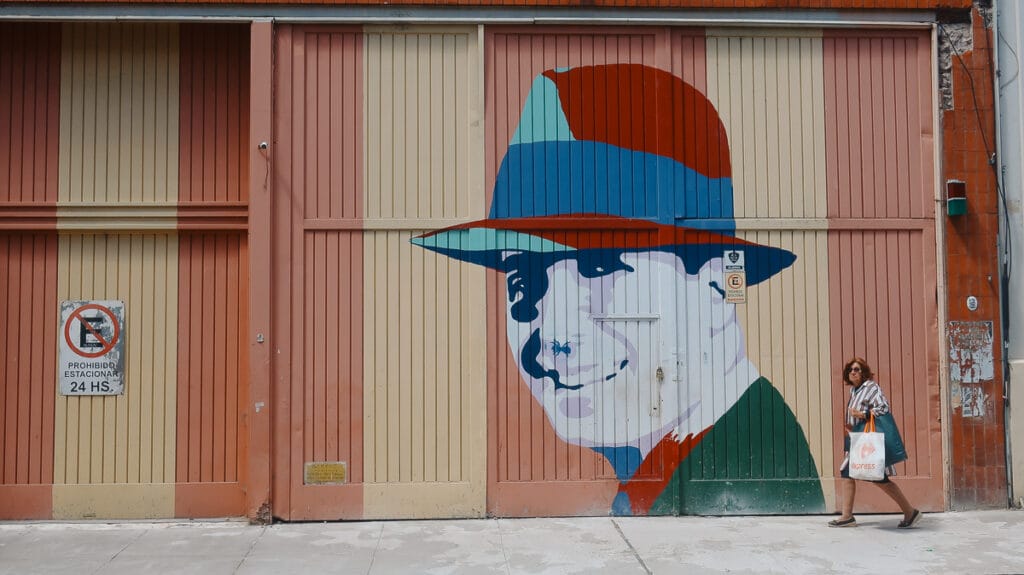
QUICK NOTE: This post contains affiliate links and Sol Salute may receive a commission for purchases made through these links, at no extra cost to you.
Almagro, Buenos Aires: A Self-Guided Walking Tour
Without further rambling, I’ll get straight to the point and get you started on this Almagro Buenos Aires walking tour.
I’m including a Google map to help you visualize the route and plan your stops.
Note that the last stops technically are in Abasto, which is part of the Balvanera neighborhood but let’s not split hairs here.
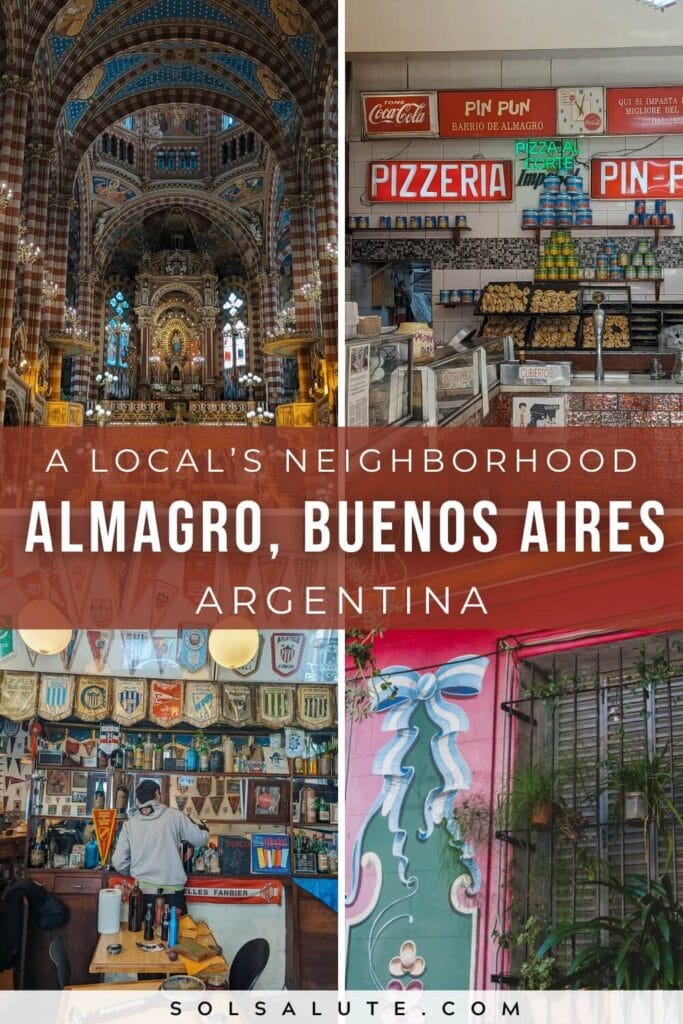
Almagro, Buenos Aires: The Map
Here is a map of the route I took, follow it to the letter or use it a jumping off point. I also mark more dining options and shops.
1. Basílica María Auxiliadora y San Carlos
📍Av. Hipólito Yrigoyen 3999
🕔 Open 7 days a week but hours vary. Check their Facebook page for most accurate hours. Typically open in the morning and evening, closing midday.
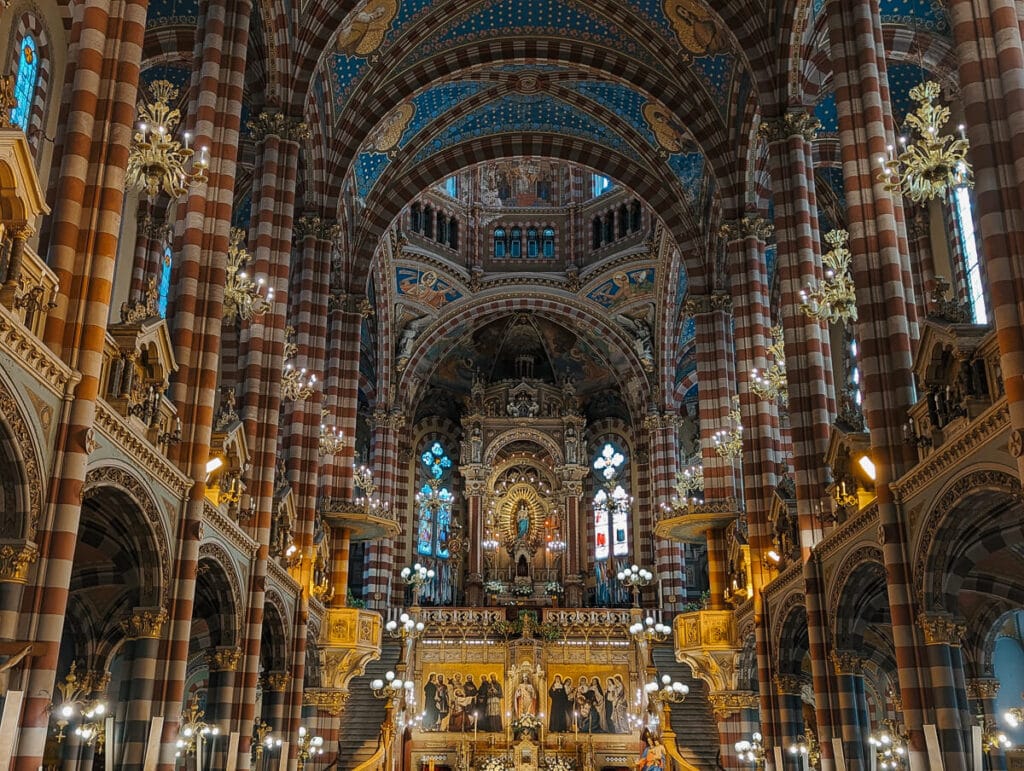
I’ve chosen start this Almagro tour here because this basilica closes for the whole afternoon. You will want to start here in the morning before noon.
The most beautiful church in Buenos Aires is not the national cathedral but this basilica in Almagro. To rely heavily on cliche, it’s breathtaking. Stand in the center and do a 360, taking in the entire ceiling and organ in the back.
It also has hosted two of the city’s most important citizens: Jorge Mario Bergoglio (a.k.a. Pope Francis) was baptized here and a young Carlos Gardel sang in its choir.
The basilica was built in less than 10 years with construction ending in 1910 and is the largest architectural work of the Salesianos of Don Bosco in Buenos Aires.
🚶🏼♀Exit the church’s front gate and hang an immediate right around the corner onto Quintino Bocayuva. Half way down the block across the street you can peek into Pasaje San Carlos to see the pedestrian alleyway and its homes that date back to 1865. Then take your first right onto Calle Don Bosco and walk two blocks.
2. Don Bosco Monument
📍Corner of Don Bosco & Castro Barros
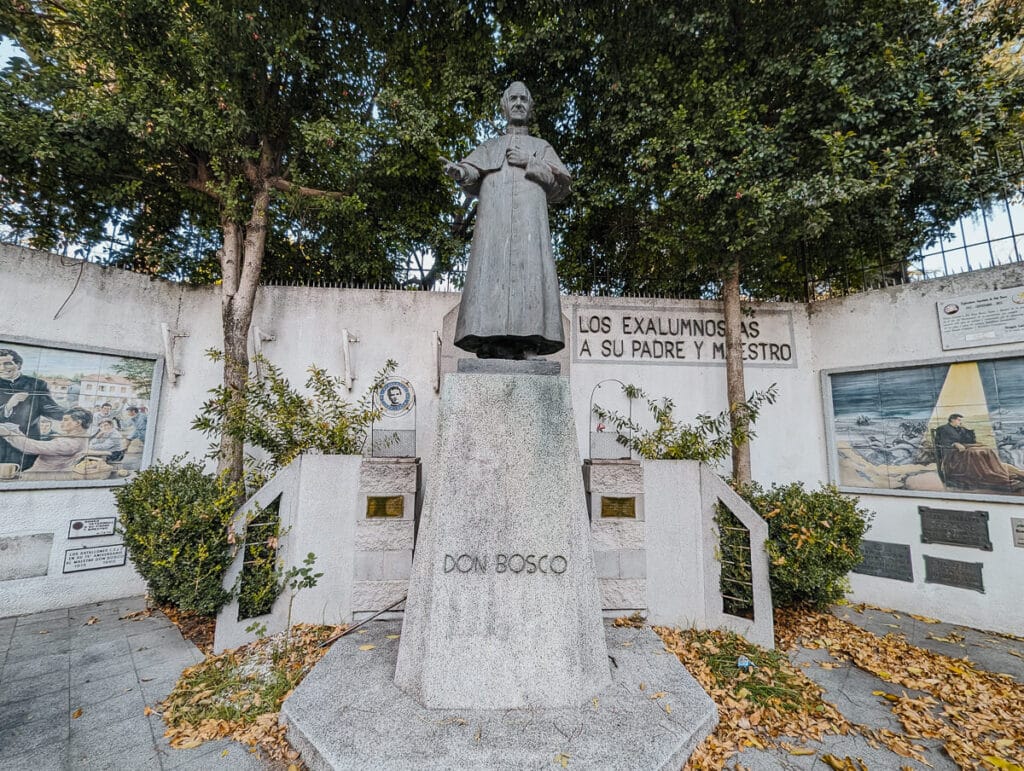
On the street corner behind a gate you’ll see a statue of Don Bosco, founder of Society of Saint Francis de Sales (also referred to as the Salesians of Don Bosco).
The Salesians arrived to Buenos Aires in 1875 and their presence in Almagro is ever present (you’re literally standing on Don Bosco street).
The Basilica and its school have made a huge impact on this neighborhood. The old school was revamped in 1961 into a trade school for technology, giving career opportunities to Almagro’s citizens.
🚶🏼♀Say goodbye to Don Bosco and walk one block down Castro Barros to Almagro’s main artery, Avenida Rivadavia.
3. Las Violetas
📍Av. Rivadavia 3899
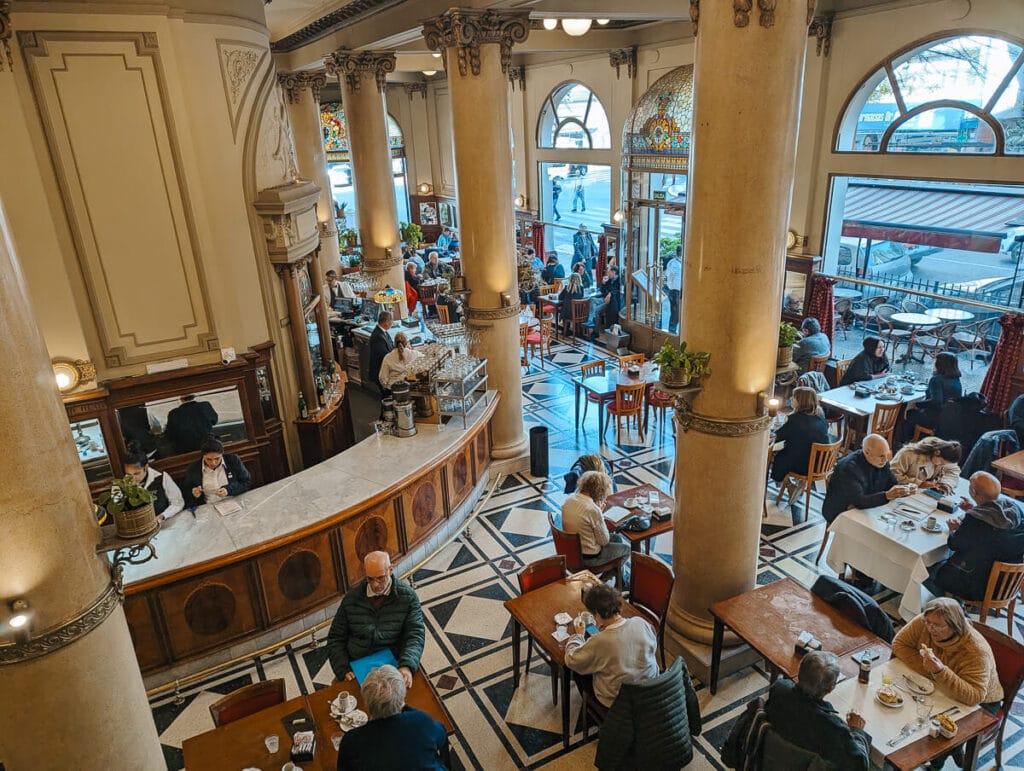
Las Violetas is the most iconic cafe in Almagro, operating since 1884.
It is refined, with furniture and decor imported from Italy and France. Poets like Alfonsina Storni frequented Las Violetas.
Today it’s known for its meriendas, or tea time. While popular among visitors, locals still meet here to catch up on local gossip and I love to people watch all the barrio abuelas chattering away here.
🚶🏼♀I have a few great spots later on to choose for lunch so don’t fill up! Grab a coffee or a cup of tea and then keep walking down Avenida Rivadavia…
4. Colegio N° 03 Mariano Moreno
📍Av. Rivadavia 3577

Public education is free in Argentina, but in Buenos Aires there are a few schools that are more prestigious and in demand than others.
The top public high school in Buenos Aires is the Colegio Nacional in San Telmo.
Colegio N° 03 Mariano Moreno was created in 1898 and inaugurated in 1911 to handle the high demand for the Colegio Nacional.
The building is stunning and stands in stark contrast to the modern apartment blocks that flank it.
From the Colegio take the next left onto Billinghurst.
5. Puente Billinghurst
The Sarmiento train line cuts through Almagro so at some point you were going to have to walk one of the many pedestrian bridges across the tracks that run below street level here.
The city government has intervened in different bridges and overpasses around the city to pay homage to local celebrities – musicians, athletes, what have you.
This bridge pays homage to Argentine literature.
🚶🏼Cross the bridge and take an immediate left down Av. Diaz Velez one block, then take a right onto Calle Mario Bravo and walk one block…
6. El Boliche de Roberto
📍Bulnes 331
🕔 Open 7 days a week from 7:30 pm
💃🏻Tango shows 365 days a year, no reservations
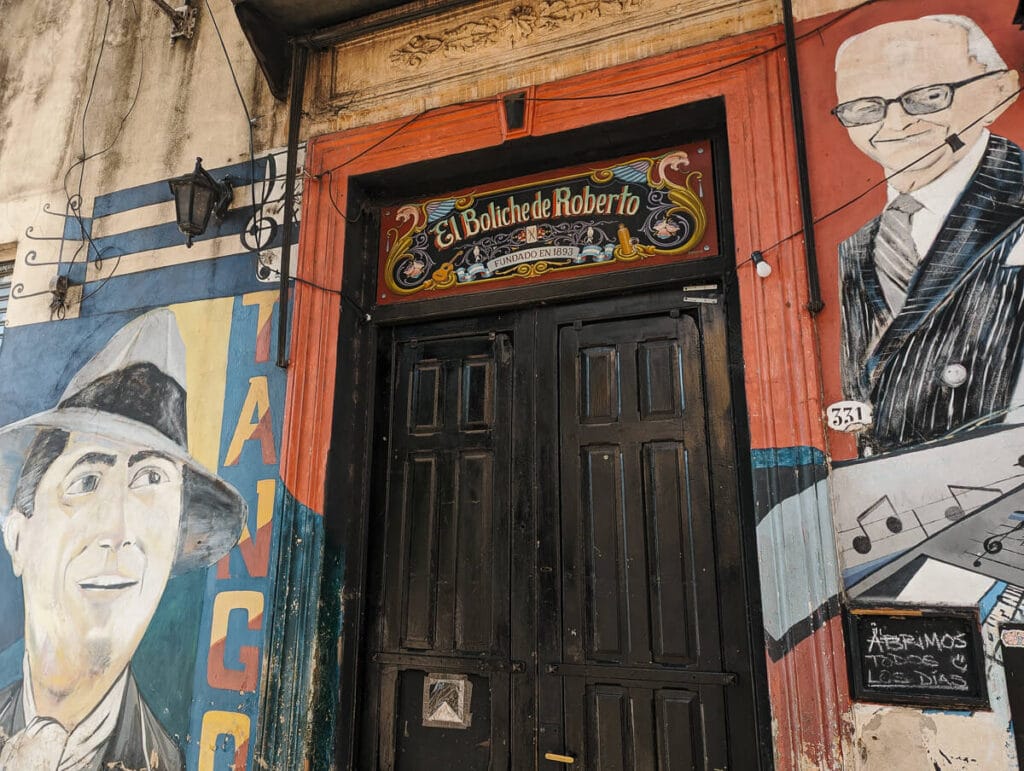
If you’re reading this as the walking tour it is written as, then you’ll likely only see the facade of this “bar notable.”
El Boliche de Roberto is a bar notable, a traditional cafe that has been officially recognized by the city for its cultural importance.
They have tango shows every night of the week – the kind locals go to, not the type of shows I feature on this best of tango list.
Keep an eye on their Instagram for schedules, special shows, open hours etc.
🚶🏼From here you’re already catty-corner from the next stop, Plaza Almagro.
7. Plaza Almagro
📍Plaza Almagro
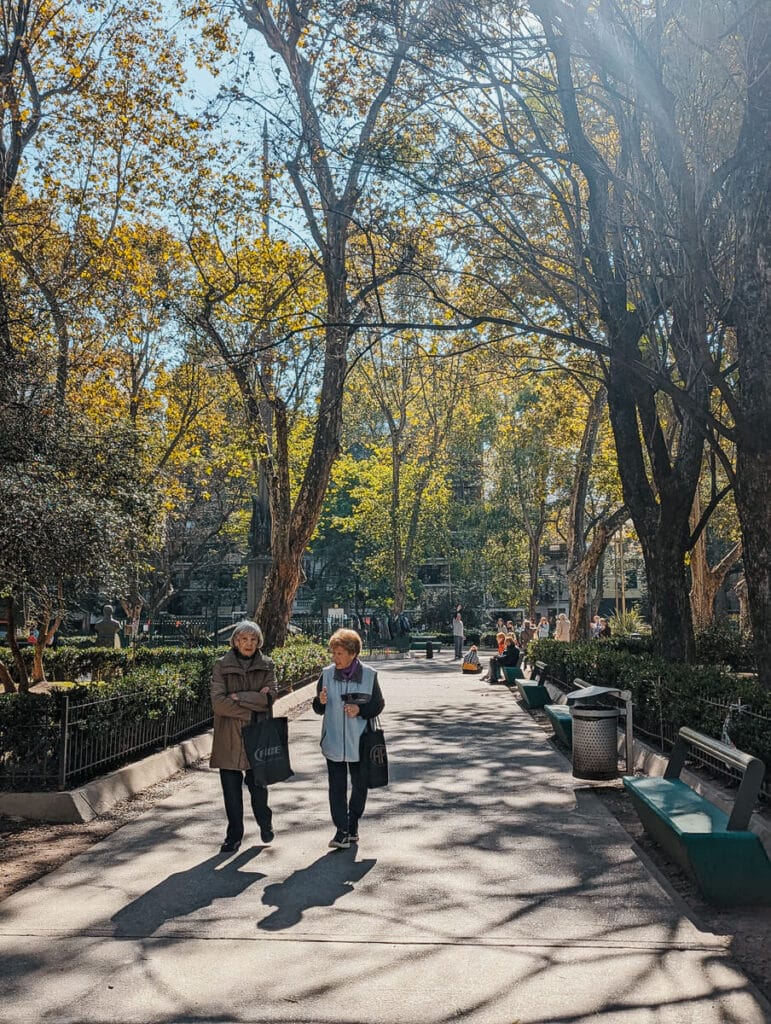
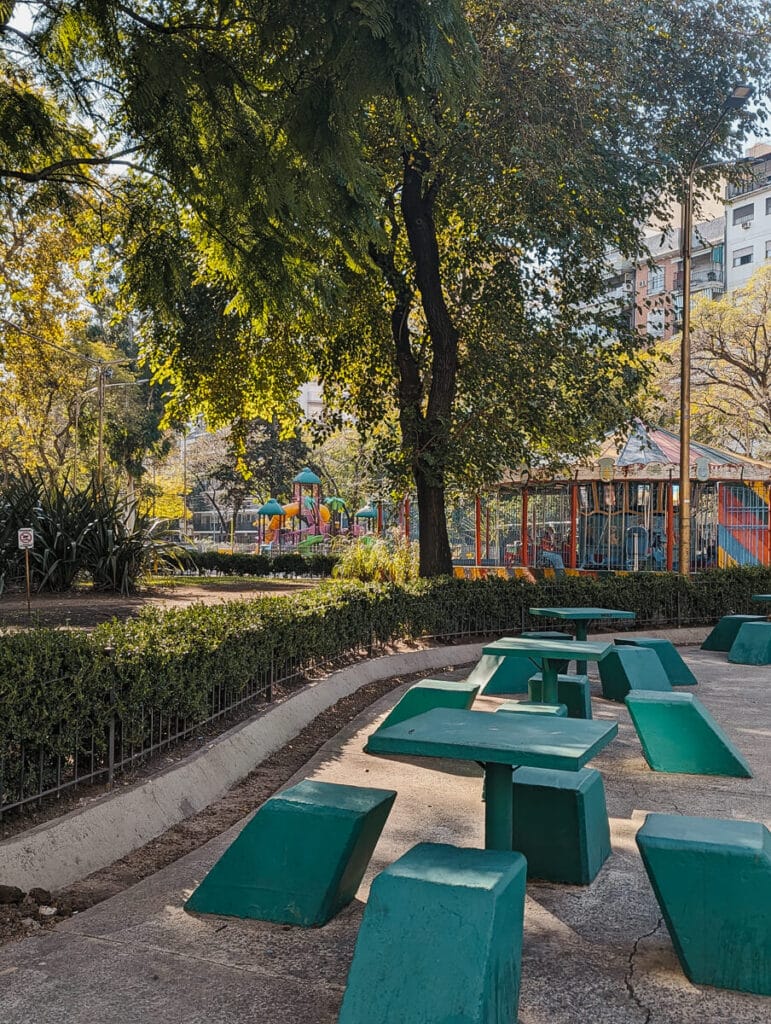
Every neighborhood has its green space or park for neighbors to meet up and get fresh air.
Almagro is densely populated so it’s Plaza Almagro is small, occupying just one city block.
Small but mighty, it has all you need for a neighborhood to function. There is a playground for the little ones, chess and ping pong tables for the older ones, and benches to rest for everyone in between.
🚶🏼Walk across the plaza to Sarmiento street and take a left two blocks to the bohemian Tango mecca – La Catedral.
8. La Catedral Club
📍Sarmiento 4006

This is La Catedral, one of the best places to dance tango like a local, with lessons, shows, and even a vegetarian restaurant.
From the outside there isn’t much to see but keep it in mind for a uniquely Almagro night out.
They’re open Tuesday-Saturday. Check their Instagram for shows and schedules.
🚶🏼From La Catedral, walk a bit down Sarmiento to Acuña de Figueroa,.
9. La Calle de las Flores
📍 Sarmiento & Acuña de Figueroa
The old flower market used to be right here and while today the market has been moved to Barracas, many flower vendors remain.
If you’re looking for a bouquet to decorate your apartment or to gift that special someone, have a wander here.
The original market was founded here in 1940 by a coop of 32 Japanese producers. It remained here for decades until neighbors won the fight against the loud overnight deliveries and in 2002 it moved to Barracas.
On Corrientes there is a huge evangelist church operating in the original building but you’ll find flower vendors in this area that was experts in what they provide.
🚶🏼Newly purchased flowers in hand, make your way to Avenida Corrientes one block up and take a right…
10. Grab a slice at Pin Pun
📍Av. Corrientes 3954
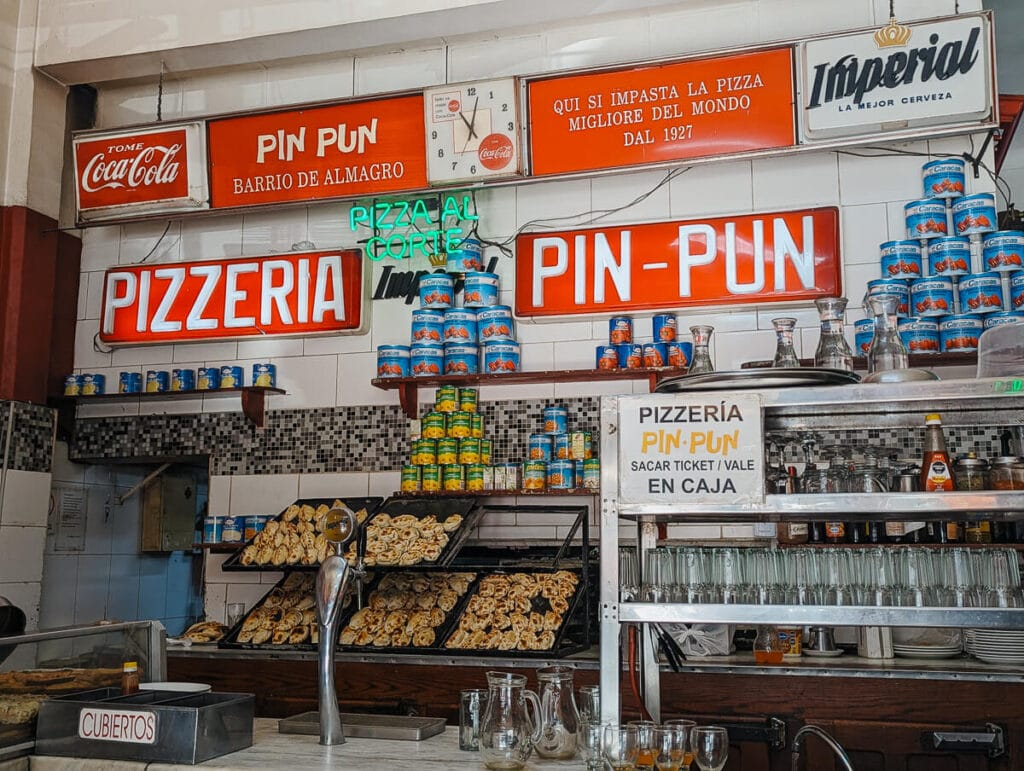
If you started this walk early, then you’re hungry for a slice. I love an old school Porteño pizzeria and Pin Pun is everything.
The bulk of the best Buenos Aires pizza is downtown on Corrientes, but Pin Pun is (while still on Corrientes) a purely Amagro gem.
Order a slice and a fried meat empanada which are fried in the window display. It’s rare I love a pizzeria empanada but their fried carne are perfection.
If ordering just a quick bite, you’ll eat standing at the bars in the front. If you want to sit in the dining room, order a larger meal/full pizza.
💡Interesting fact: The reason Pin Pun is so good is because it was opened by the same Italian immigrants behind Güerrin, so if you’re looking to get away from the Güerrin crowds downtown, head to Pin Pun.
🚶🏼Walk three blocks and turn left on Billinghurst. I love the architecture on this intersection and feel like the vibe of the walk changes down Billinghurst. It is leafy, cozy, and photogenic. Walk down Billinghurst 2 blocks to…
11. La Esquina de las Aceitunas
📍Guardia Vieja 3602
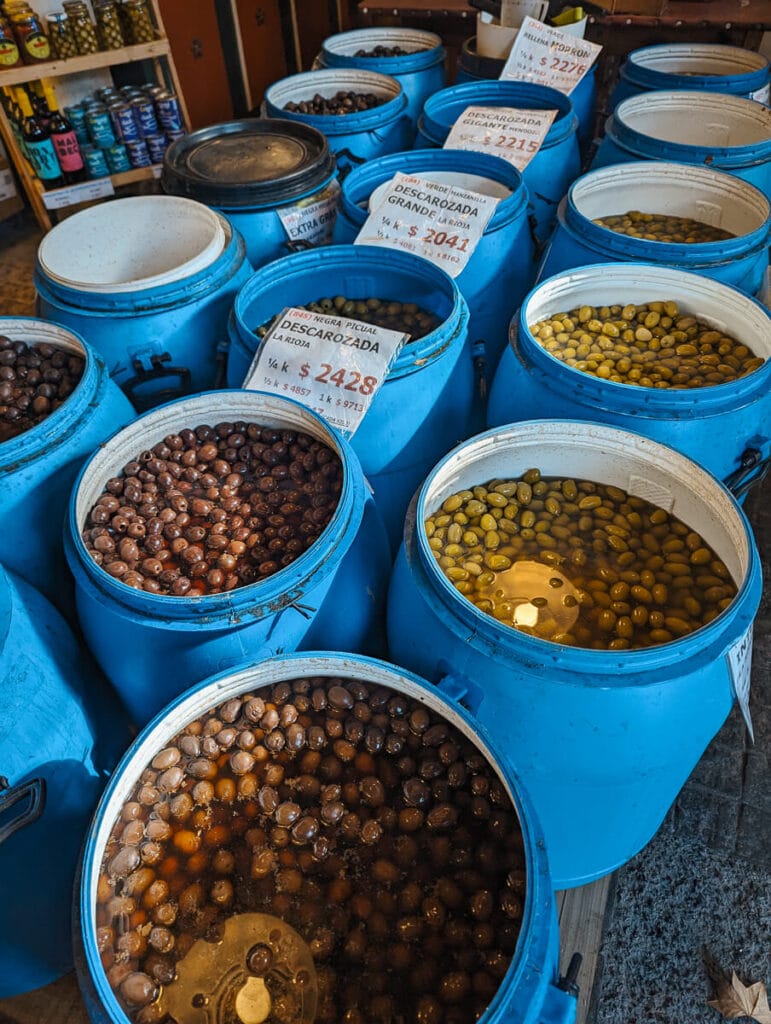
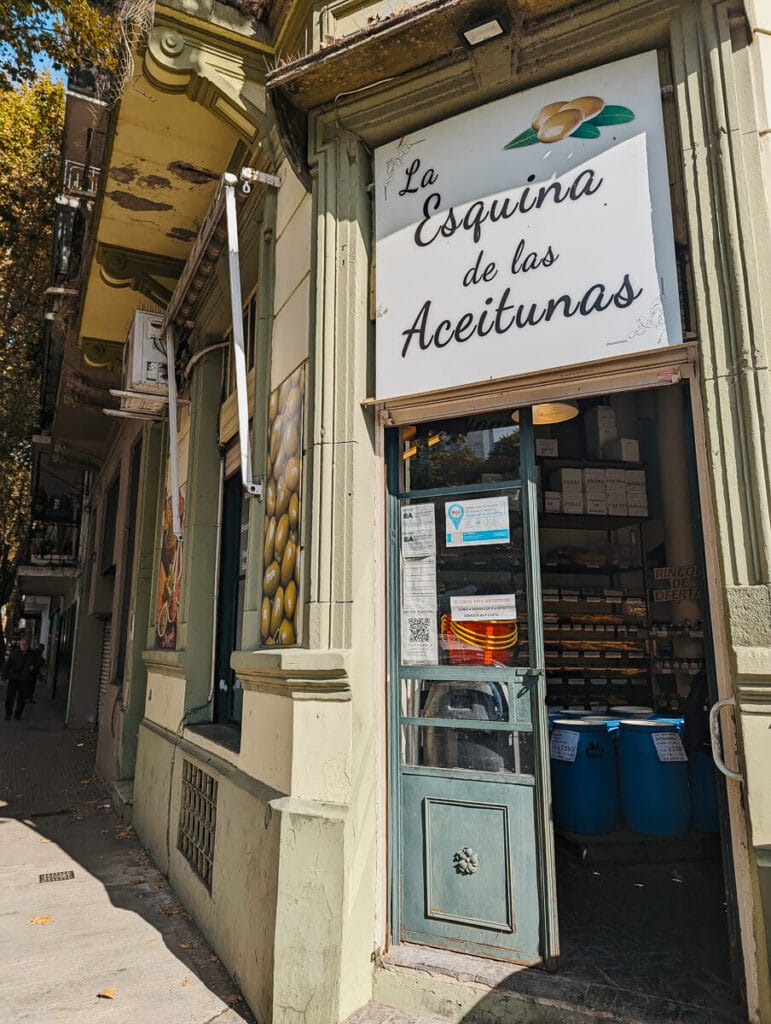
On the corner of Guardia Vieja y Billinghurst is La Esquina de las Aceitunas, owned and operated by the same Greek family since 1958.
Hailing from southern Greece, an area known for its olives, Constantino Katsaunis opened this corner with the assistance and partnership with a Mendocino.
Constantino saved to purchase a truck which he used to deliver groceries (including olives, of course). On his deliveries he met Gabriel Mesquide, an olive producer from Mendoza, and together they opened this store.
The location is no accident, located just a few blocks from the Mercado de Abasto, the largest market in the city (today a shopping mall). Today, the store is run by his great-nephew who still sells a huge variety of olives (seriously, the smell hits you in the face when you walk in).
If you love olives, definitely go in and pick up one of their unique filled varieties like tuna, king crab, jamon crudo, and more.
🚶🏼Cross the street…
12. Grab a drink at El Banderin
📍Guardia Vieja 3601

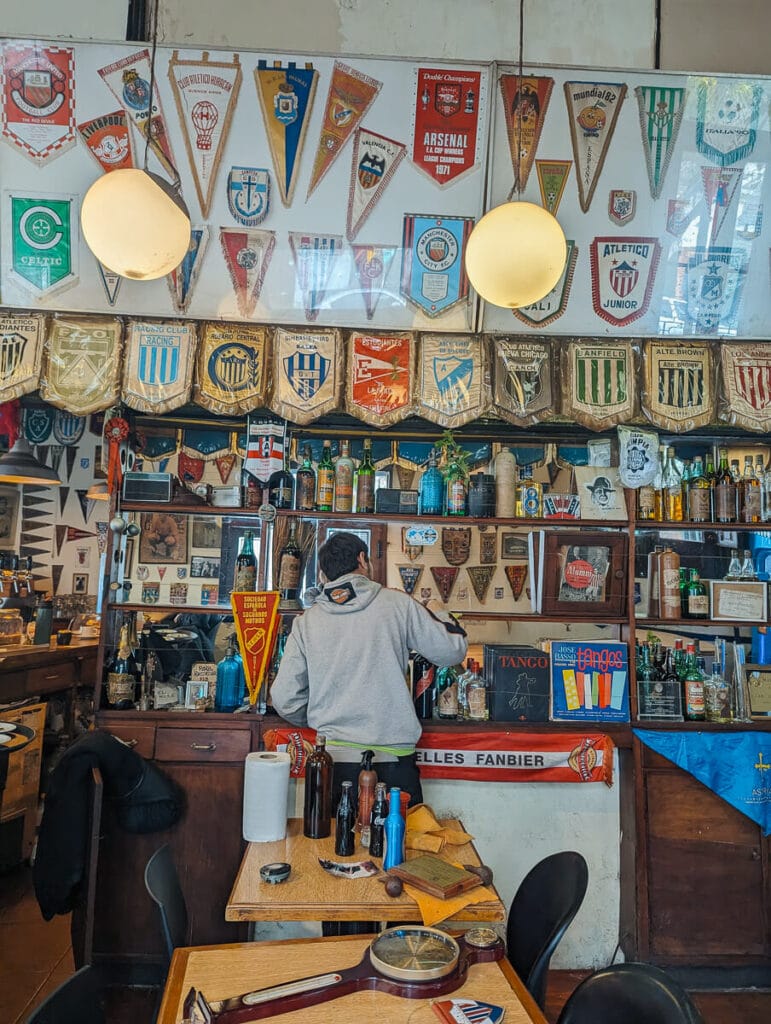
Like Las Violetas, El Banderin is also a bar notable – a historic bar noted by the city for its cultural importance.
But where Las Violetas is refined and European, El Banderin is a bit rougher around the edges, decorated in football banners (the banderines). Send grandma to Las Violetas, and grandpa to El Banderin.
It’s been open since 1929 and got its name from the more than 500 football flags that decorate its walls.
Grab a coffee or a drink (a vermouth and soda to fit in) and relax here a bit.
🚶🏼Disclosure for the nit-pickers, I’m taking us out of Almagro and into Abasto now (technically Balvanera). From El Banderin, walk one block up to Lavalle and take a right and walk three blocks. Take a left on Aguero and take an immediate right half a block up onto Pasaje Zelaya…
13. Pasaje Zelaya Gardel Murals

Pasaje Zelaya is a short 2 blocks but is filled with cultural centers and street art. The bul
On Pasaje Zelaya, you’ll find a number of portraits of Carlos Gardel – all painted by artist Marino Santa María, best known for his mosaic work on Calle Lanin in Barracas.
The two portraits that call the most attention are on the door of a huge warehouse and on the wall above the tango bar on the corner, both on different corners of Anchorena and Zelaya.
Catulo Tango is here on the corner, if you’re looking for a Buenos Aires tango show.
One of Gardel’s murals towers over its picture perfect corner.
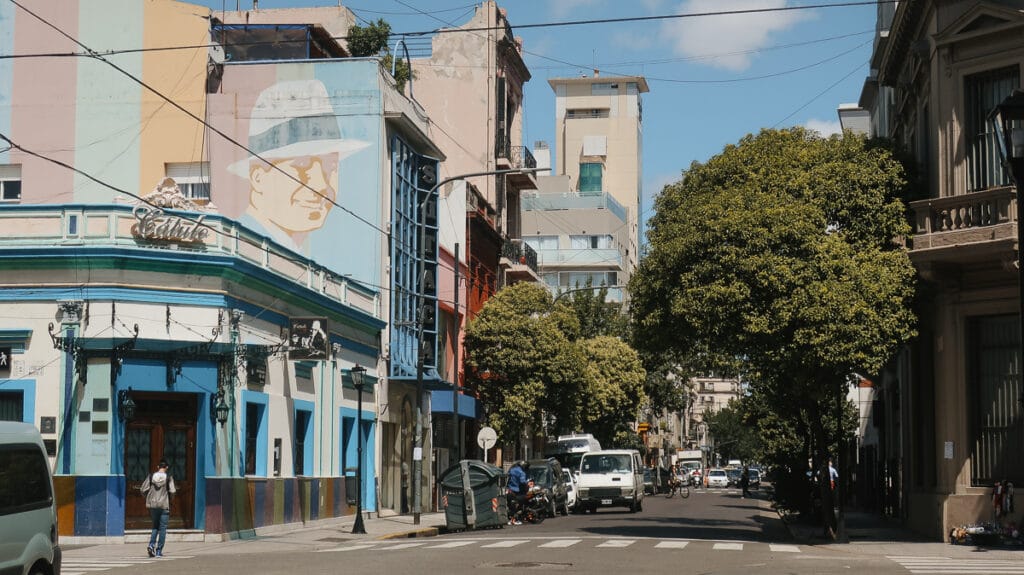
💡TIP: Across the street from the warehouse Gardel mural is a fantastic vintage store, Alma Zen. If you want to go shopping in Buenos Aires, don’t miss it.
Here on Zelaya you are just a steps from Carlos Gardel’s last home here in Buenos Aires, and our next stop on this walk.
🚶🏼Keep walking down Zelaya until you bump into Jean Jaures street.
14. El Paseo de Filete
📍Jean Jaurès 737
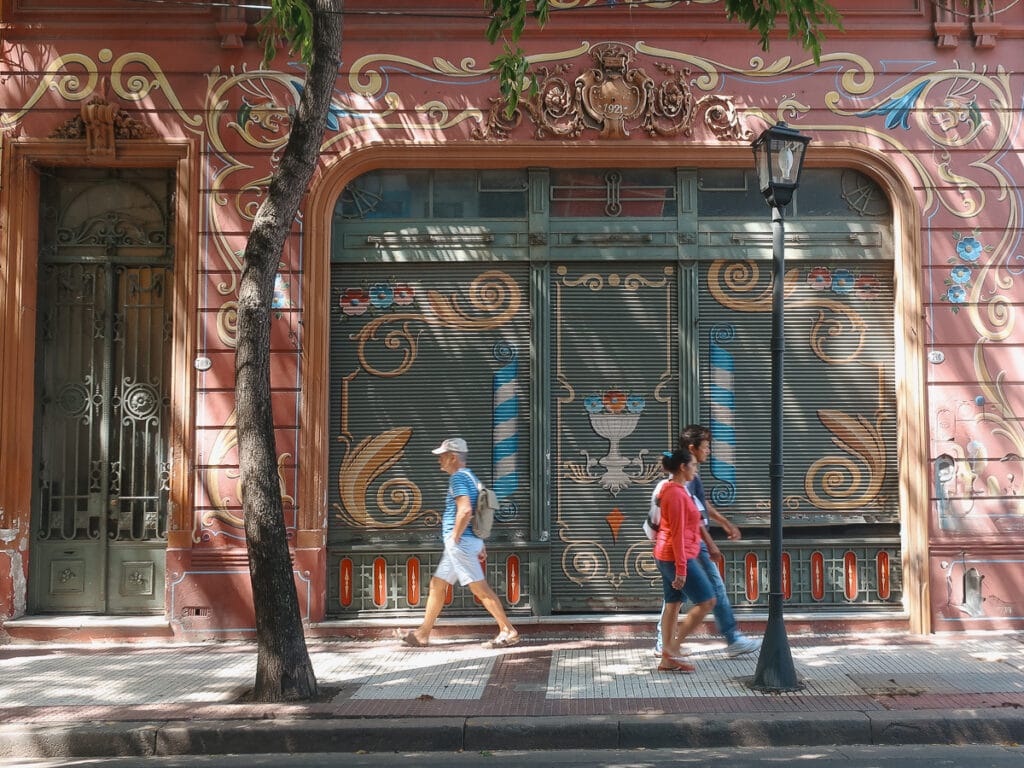
As part of a contest and move to revitalize the block surrounding Carlos Gardel’s home, 6 facades were painted in traditional fileteado.
But, what is fileteado, you ask?
Fileteado is a a style of painting unique to Buenos Aires and characterized by swirled lines and floral designs. It’s colorful and uniquely, purely Buenos Aires.
It was originally used to paint horse drawn carriages but became omnipresent on shop windows, modern city buses, and of course, souvenirs galore in the Buenos Aires outdoor markets.
These homes and store fronts are particularly gorgeous, having such huge examples of Fileteado one next to the other is something you won’t see elsewhere.
15. Museo Casa Carlos Gardel
📍Jean Jaurès 735
🕔Confirm opening hours by checking here, but note that it’s closed on Tuesdays.
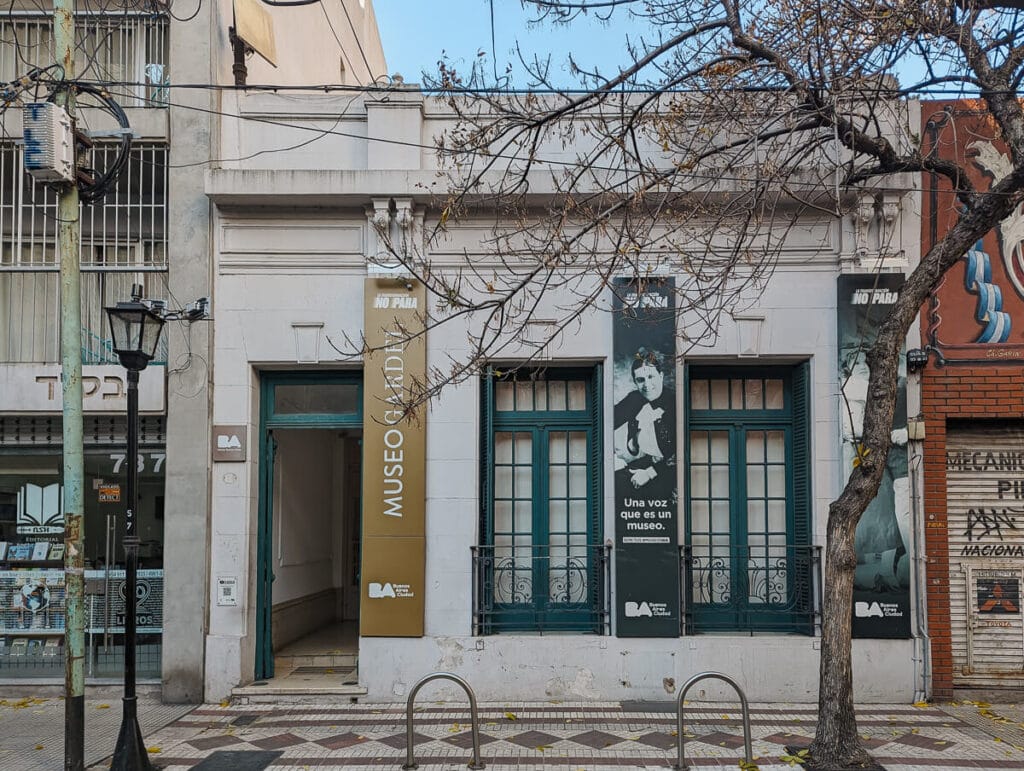
If you’ve ever heard tango, you’ve heard Carlos Gardel who is without a doubt, the most internationally renowned tango singer.
This tango giant may have been born in France but he spent most of his life here in Almagro.
He lived in the same home even after making it big internationally, refusing to leave his roots and beloved barrio.
His home, which he shared with his mother, has been converted into a museum showcasing his life.
Entrance is very affordable at $500 pesos for Argentine residents, $3,000 for foreign tourists.
16. Abasto Shopping
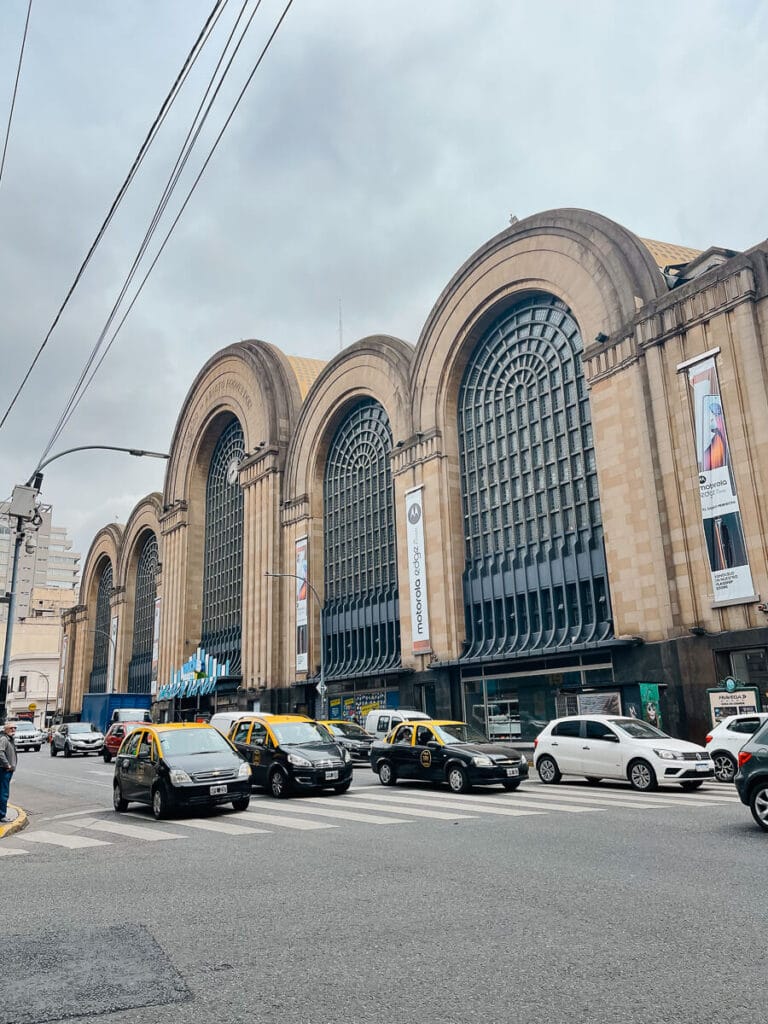
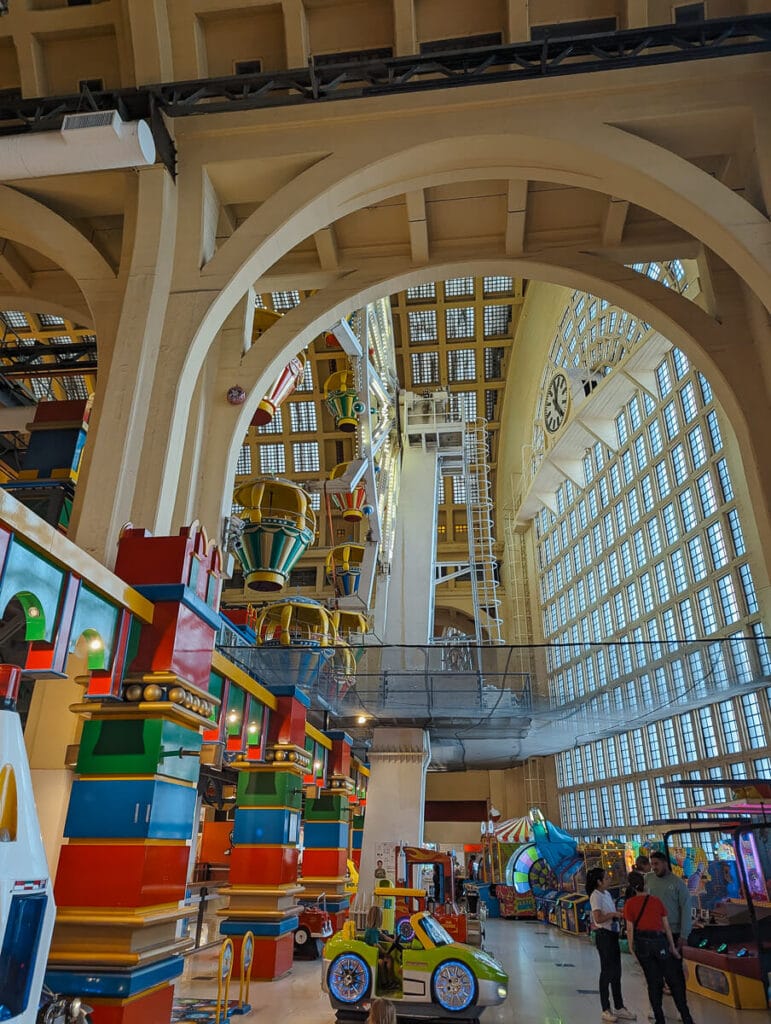
This walking tour ends in one of the city’s biggest malls (of all things).
But this hasn’t always been a mall, in 1889 construction began here on the city’s Central Market.
At the time this area of the city was considered the outskirts and was centrally located between Buenos Aires’ two main agricultural hubs of La Boca and Olivos.
It seems insane to think about today, when all of these areas are very urban today.
In 1934, this market was re-constructed and amplified to cover 44,000 square meters.
It remained the main market for the city until 1984, when the Central Market was relocated outside the city.
This building lay abandoned until it was remodeled into the shopping mall you see today in 1999.
What to see inside?
The building is huge if you want to appreciate it, head up to the top floor food court where you can see the roof’s arches up close. This is also where you’ll find:
- Kosher McDonald’s: Keeping Kosher but still want a Big Mac? The McDonald’s Abasto is the only kosher McDonald’s in the world outside of Israel and it’s right at home serving Buenos Aires’ large Jewish population (learn more with this Jewish heritage tour).
- Museo de los Niños: If you’re traveling with kids they will LOVE this Children’s Museum. For more information and hours check the official site, there are three shifts of 2 hours each, you can book ahead or just get tickets there. I regularly being my two kids here and they LOVE it, it’s easily one of the best things to do with kids in Buenos Aires.
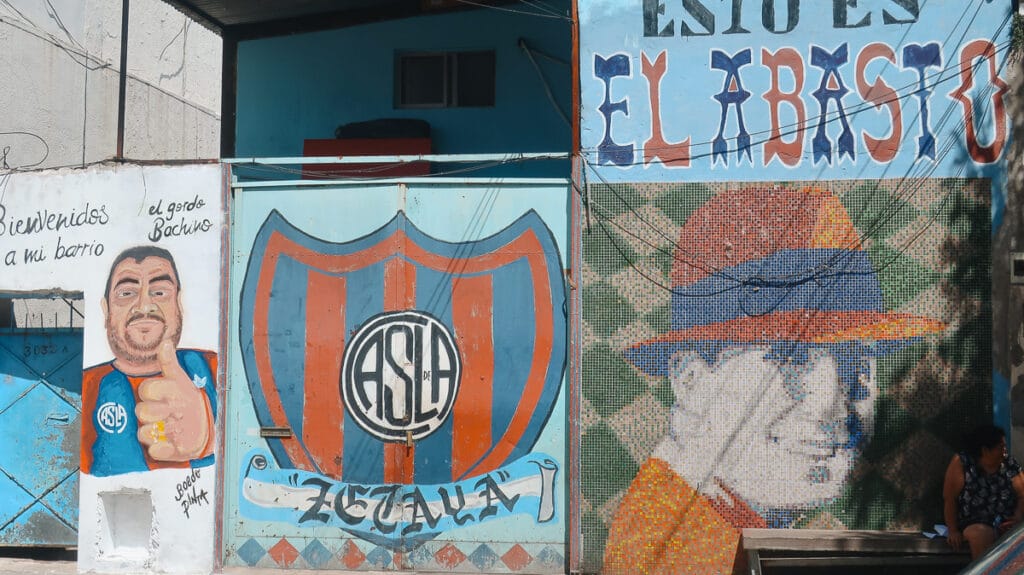
Now what: What else to do in Almagro?
This tour ends here in Abasto, you can keep wandering by walking through Balvanera with this neighborhood guide.
Here are a few more options on things to do, especially if you’re looking on something to do in Almagro at night.
- Take the subte | If you’re going home, consider taking the Sube Line B here (there is a station below the Abasto Shopping. Street art and murals decorate the walls of all of Line B’s stations so it is a bit of a DIY Buenos Aires street art tour.
- Eat Peruvian | This area (as well as neighboring Balvanera) is home to the best hole-in-the-wall style Peruvian restaurants in the city, like Mamaguille’s or La Conga.
- Visit El Boliche de Roberto & La Catedral | Looking for a “real” tango experience (versus these popular tango dinner shows)? La Catedral offers tango classes every night (think 6-9 pm), but if you already know what you’re doing, the real action gets started late into the night. Check classes and events here or spend the evening at El Boliche de Roberto. Both places are part of the above walking tour but to actually see them, you’ll need to go at night.
- Bomba del Tiempo @ Konex Cultural Center | Looking for a fun night out on a MONDAY? Hit up the Konex Cultural Center. Their most popular event is the Bomba del Tiempo drum show every Monday night. With a proper conductor directing the show, it is unlike anything you’ve seen before. There is an after party as well and both are safe but do be aware of your belongings in the crowds (like in any crowd).
Looking for something to do at the head of this tour? The neighborhood of Boedo is near the start! You don’t need much time to explore so read my guide to Boedo, Buenos Aires and head there before this Almagro walk.
Argentina Travel Resources
- BOOK A CONSULTATION | I offer one-on-one travel consultations to help you plan your trip to Argentina. Pick my brain to get a local’s insight. Click here for more information.
- MY MAP | Buy my interactive map with 300+ pins to have access to the city as I see it. It is an invaluable resource. See more here about how it works.
- AIRPORT TRANSFERS | Having a driver waiting for you is ideal for a stress free arrival, Welcome Pickups is the best option for a driver from Ezeiza or Aeroparque.
- TRAVEL INSURANCE | Always travel insured. Anything can happen anywhere and it is scarier and costlier in an unfamiliar country. SafetyWing’s Essential Plan covers unexpected travel and medical emergencies and even offers add-ons like electronics theft or adventure sports. It is the best if you’re coming on vacation. If you’re coming as a digital nomad or an extended stay, you need their Complete Nomad Plan which also covers routine check ups, maternity, mental healthcare and more. Read more: Health Insurance in Argentina
- PHONE PLAN | These days, traveling with data is essential. Especially in Argentina where everything is managed on Instagram and WhatsApp. I recommend this E-SIM card. It’s hassle-free and affordable, for more read how to get an Argentina sim card.
- ACCOMMODATION IN ARGENTINA | booking.com is the most common hotel site used in Argentina and it’s where you’ll find the most options.
- RENTAL CARS | I love to travel Argentina via road trip, I’ve always used rentalcars.com, now they are operating under the umbrella of Booking.com’s car rental system.
- BUS TICKETS | Check Busbud for long distance bus routes and tickets.
- VPN | If you’ll be using a public WiFi connection and want to secure your data, I highly recommend using a VPN, I personally use and have had a good experience with ExpressVPN. I also use it to access Hulu and American Netflix from Argentina.
- FLIGHTS | Always check Google Flights and Skyscanner for flights to and within Argentina. Aerolineas Argentina is the local airline with the most routes. FlyBondi and Jetsmart are two budget airlines with dirt-cheap prices (but expect to pay for every add-on like luggage).



Fantastic walk! Just completed it. It’s so helpful, it takes a lot of time to plan one of these, and your knowledge and experience are really helpful. Thank you!